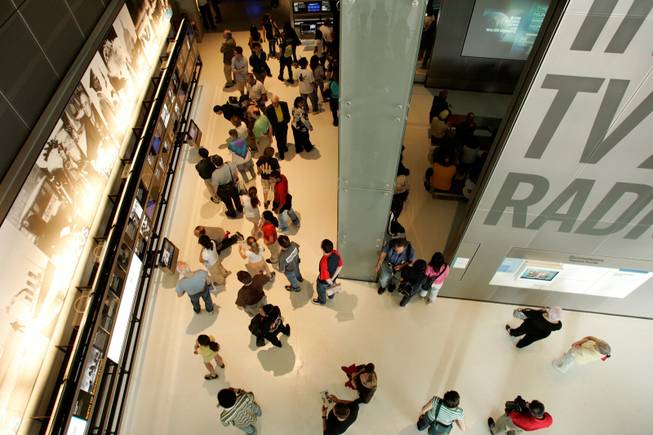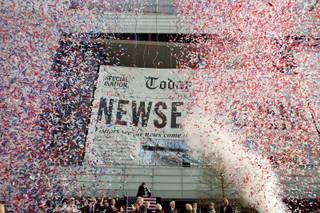
A gallery of television, Internet and radio memorabilia is one of 14 exhibit areas in the Newseum, which opened Friday in Washington. Among other galleries is one dedicated to newspaper front pages from the day after the Sept. 11 attacks.
Sunday, April 13, 2008 | 2 a.m.
Newseum Makes Headlines
Senate Majority Leader Harry Reid, U.S. Rep. Shelley Berkley, D-Nev., and comedian Steven Colbert each give their own unique perspectives on Washington D.C.'s tribute to the First Amendment, the Newseum.
Newseum Walkthrough
Take a multimedia stroll through the Newseum without all the hassle of traveling. In this two-and-a-half minute time-lapse video, you'll see all of the Newseum's major exhibits - minus the $20 ticket fee.
The Newseum's Las Vegas Connection
The recently opened Newseum in Washington, D.C., shines a spotlight on Las Vegas, with a sixth-floor terrace dedicated to Las Vegas Sun founder and former publisher Hank Greenspun. U.S. Senate Majority Leader Harry Reid, U.S. Rep. Shelley Berkley, D-Nev., and others share their thoughts on Greenspun's impact on both Las Vegas and the journalism profession. See story.
Beyond the Sun
FIVE NOTABLE QUOTES
1 Standing outside the Newseum before the official opening, Guam native Lou Barrett teared up as she considered the 75-foot tall marble slab of the First Amendment on the building front. “Just the whole idea that we in this country can express our opinions — right next to the White House and Capitol — that’s awesome,” she said. “People just don’t appreciate what we have in this country. They really don’t.”
2 Cindy Schaefer, in with a friend from the Virginia suburbs, was moved by the exhibit featuring actual portions of the Berlin Wall to show the difference in freedoms of expression between East and West Germany during Communism. “There is just such a stark contrast,” she said. “We take that so for granted, until you see that exhibit.”
3 Nine-year-old Riley Noyez, with her younger twin sisters Reagan and Reese, spoke for the family. “We thought it was probably the funnest museum we’ve gone to.” They loved “the reporter game,” she said of the video-game-like interactive where visitors can interview sources and craft a story. “You had to use your mind to think about it, but in a fun way.”
4 Comedy Central’s Stephen Colbert sent the Newseum a congratulatory video greeting in which he suggested the institute, to better reflect the state of media today, should rename itself the Newsoleum — until he realized without the daily front pages, “I wouldn’t have a show.”
5 Chief Justice John G. Roberts helped dedicate the museum, quoting a First Amendment scholar who called the media “ ‘a wild animal within our midst’ — and he meant that in a favorable way.”
FIVE NOTABLE NUMBERS
14 — Founding partners, including The New York Times’ Ochs-Sulzberger family and the Greenspun family, owners of the Sun
14 — Major galleries, including a section devoted to the front pages of the day
15 — Theaters, three of which are contained within other galleries
137 — Height, in feet, of the Newseum, at its highest point. The Great Hall of News atrium is 90 feet tall
250,000 — Square footage of the Newseum. And the total size of the project? 643,000 square feet
Along historic Pennsylvania Avenue, where visitors stroll and new presidents make the inaugural trip to their new home, stands the latest addition to the civic tour of the capital: A museum of the Fourth Estate.
The sleekly modern glass and steel Newseum looks in some ways like a stack of newspapers, as a congressman from Nevada mused. From another view it resembles a massive TV or computer monitor, appropriate enough for today’s nonstop news.
Yet its most breathtaking contribution to the skyline is the 75-foot welcome sign — a giant marble billboard of the First Amendment, “Congress shall make no law ... abridging the freedom of speech ...”
It has endured for 217 years, throughout the complicated history Americans have with the press. They love the notion of the freedoms protected in the First Amendment, even if they don’t always feel warmly about the media that deliver the news.
The Newseum creates a surprisingly entertaining venue for untangling this cornerstone of American democracy.
Walk inside the soaring lobby and suddenly you’re immersed in the news. Today’s headlines stream across giant monitors like the crawl at the bottom of cable news shows. A traffic helicopter hangs from the ceiling overhead. Artifacts from centuries of news are tucked into every gallery.
Think of it as a brainy theme park of American civic history. Displays are technologically sophisticated enough to wow the iPod generation, but like a good newspaper story, are educationally rich once you delve beyond the headlines.
Newseum Chief Executive Charles Overby said 20 million visitors come to Washington each year “to see their democracy in action. We believe that the press belongs in that pilgrimage.”
The $450 million museum is the outgrowth of a smaller institution once located across the Potomac River. Primary support comes through The Freedom Forum, a free press foundation established in 1991 by Al Neuharth, founder of USA Today.
The new institution came into being with financial contributions from 14 of the nation’s media companies, including a $7 million gift from the Greenspun family, which owns the Las Vegas Sun.
The exhibits, spread through 14 galleries, are as much about history — yours, the country’s, the world’s — as they are about news. In one gallery, a towering bank of TV screens rolls clips from decades of broadcasting. In another, a wall full of front pages shows the story as it appeared in newspapers around the world the morning after Sept. 11. Another shows every Pulitzer Prize-winning photograph since the first one was awarded in 1942.
The oldest artifact in the museum is cuneiform brick. The sassiest may be the turquoise slippers Wonkette editor Ana Marie Cox wore in her days as a pioneering blogger. Perhaps the saddest is the bloodstained notebook of an Iraq war correspondent who lost his right hand tossing a grenade out of a Humvee.
Interactive displays let visitors try the craft. You can investigate (on deadline) how the animals broke free at the circus or choose whether it was right for a photographer to take a picture of a starving child as a vulture hovered.
Movies run throughout the theaters. “The Press Box” shows clips from 100 years of sports reporting. A 4-D venue lets visitors feel what it might have been like to stand with Edward R. Murrow reporting from a London rooftop during the German bombing of World War II. Others debate anonymous sources, media bias and reporters’ mistakes.
Mark Feldstein, a professor of media history at George Washington University, said the institution “allows the public to get a sense of what it’s really like to be a reporter, that it’s not so easy and clear cut, and you have to make snap decisions.
“Lots of people have had the experience of seeing a news story about something they know about and being disappointed,” he continued. “For the public to see how it comes about, how these stories are put together, is good for everybody.”
The steep entrance fee of $20 for adults ($13 for youths, free for children 6 and younger) has its critics. Museum officials remind that they have to pay bills and do not receive tax dollars, as other museums in the capital do.
Visitors might also want some spending money for the gift shop, which has somehow made the tools of the trade marketable, with glossy versions of the classic Reporter’s Notebooks that stick out of back pockets and salt-and-pepper shakers modeled after canisters of film.
Some critics no doubt think the last thing journalism needs is a museum to a profession susceptible to its own hype, particularly in the nearly 34 years since Watergate brought down a president, Richard Nixon.
But Feldstein said it might be a good thing to show Americans, as they look at the memorial wall of journalists who have died in the line of duty, what the job is all about.
The museum’s intent is to remind us that a free press ensures you have the ability to read this or any other story — or even, in this Internet age, create one of your own.
As museum director Overby said: “I worry the First Amendment as we know it won’t exist at the end of this century unless a lot of us are more vigilant than we have been. This whole museum is designed to try to make sure the First Amendment is here as long as the building is here.”
Nearly four decades ago, the Nixon administration mounted an unprecedented attack on the First Amendment, ultimately failing in the Supreme Court to prevent The New York Times from publishing a secret government report.
On Friday, Las Vegas Sun Editor Brian Greenspun, who toured the Newseum with his family, said there may be no better place to display the 45 words of the First Amendment than on the front of the Newseum.
“Judges, congressmen, senators and even the president go up and down Pennsylvania Avenue,” Greenspun said. “When they see those words, it will remind them that there is a First Amendment.”
The Sun’s Matt Toplikar contributed to this story.


Join the Discussion:
Check this out for a full explanation of our conversion to the LiveFyre commenting system and instructions on how to sign up for an account.
Full comments policy